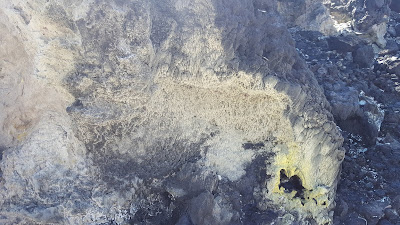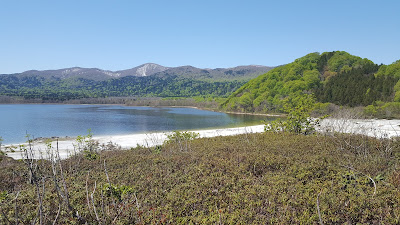恐山行く前に泊まった宿で朝食を先にとります。
It was not a very long drive and we soon reached our destination.
恐山は大畑町からそんなに遠くなかったため目的地にすぐ辿り付きました。
It is Golden Week after all so it wasn't unual to see the carp streamers that are displayed for Children's Day which is celebrated every May 5th.
ゴールデンウィークの最中なので、鯉のぼりをみかけるのは珍しくない。毎年の5月5日はこどもの日だ。
Bridge over the Sanzu River / 三途の川の上にある橋
The Sanzu River is similar to the River Styx. In Buddhist tradition it is the river the dead must cross on their way to the afterlife.
三途の川はギリシャ神話のハーデースの川(英語だと通称リバー・スティックス)と同じような川です。死者が天国への道に必ずこの川を渡らなければなりません。
On top of the bridge over the Sanzu River.
三途の川の上に立ってる私たち。
Our travel companions Yukio and Reiko.
旅仲間の幸男と玲ちゃん。
Statues of Datsueba and Keneou / 奪衣婆と懸衣翁の像
Datsueba is an old woman who sits by the shore of the Sanzu River. According to Wikipedia "...when a child dies its soul has to cross the Sanzu River. Traditionally, when a person dies, it is believed that they can cross the river at three different spots depending on how they lived their lives. Since children have not accumulated enough experiences, however, they are unable to cross. At the river's edge, the souls of deceased children are met by Datsue-ba. There, she strips the children of their clothes and advise them to build a pile of pebbles on which they can climb to reach paradise. But before the pile reaches any significant height, the hag and underworld demons maliciously knock it down. The Buddhist Jizo saves these souls from having to pile stones eternally on the bank of the river by hiding them in his robe."
奪衣婆とは三途の川で死者の衣服を脱ぎ取る老婆の鬼。
Keneo is an old man who sits by the shore of the Sanzu River. According to Wikipedia and Buddhist folklore, "W
hen a soul of an adult arrives at the river, Datsueba forces the sinners to take off their clothes, and Keneō hangs these clothes on a riverside branch that bends to reflect the gravitnishment are then performed by the pair. For those who steal, for example, Datsue-ba breaks their fingers, and together with Keneō, she ties the sinner's head to the sinner's feet.
懸衣翁とは”奪衣婆と共に十王の配下で、奪衣婆が亡者から剥ぎ取った衣類を衣領樹の枝にかけ、その枝の垂れ具合で亡者の生前の罪の重さを計るとされる。 罪の重い亡者は三途の川を渡る際、川の流れが速くて波が高く、深瀬になった場所を渡るよう定められているため、衣はずぶ濡れになって重くなり、衣をかけた枝が大きく垂れることで罪の深さが示されるのである。また亡者が服を着ていない際は、懸衣翁は衣の代わりに亡者の生皮を剥ぎ取るという”。
Six Large Jizo / 六大地蔵
恐
The temple office building.
Walking the path to the main templ
The hongo or main temple / 本堂
Beautiful wooden carvings.
素晴らしい木製の彫刻。
Inside the hondo.
本堂の中。
The sanmon or second gate you must go through before getting to the main temple.
本堂に行く前にこの山門も通らないっと。
Nio statues - guardians of the gate.
山門の仁王像。
Temple grounds / 境内
That small building in the center of the picture is the Osorezan hot spring. Yes, there is a hot spring on the temple grounds.
写真の中心にある小さな建物は男性用の温泉です。はい、境内に温泉があります。
Looks like some turtles to me.
亀がいっぱいいる。
Hondo / 本堂
Prayer boards / 絵馬
Crypt Tower / 納骨塔
A bit of sulfur on the rocks.
硫黄の匂いが強い。
The signs says "Infinite Hell".
無間地獄と書かれてる。
Daishi-do / 大師堂
Dai Heiwa Kannon (Kannon for peace) / 大平和観音
This pond has a scary name. It's called the "Chi no Ike Jigoku" which translates to something like "Blood of Hell Pond".
恐ろしい名前の池ですね。「血の池地獄」。
Kind of creepy with all the hand prints.
手形がいっぱいでちょっと不気味な感じがする。
Mizuko Jizo / 水子地蔵
Juzai Jigoku (Felony Hell) / 重罪地獄
Kanabori Jigoku / 金堀地獄
Toba-do (building for stupas) / 塔婆堂
I had to get my temple seal as well.
もちろん恐山の御朱印を忘れずに。
We had lunch at the only restaurant near the temple.
恐山の唯一のレストランでランチを食べた。
And a bit of dessert before heading back towards Aomori City.
そして青森市に戻る前のデザート。
We also got some water from Mount Osore.
恐山の冷水も飲んでみた。
And that ends our adventure at Mount Osore and Bodaiji Temple. Now for the long drive back to Aomori City.
そして恐山 募提寺の探索が終了しました。これから青森市を目指します。


















































































































No comments:
Post a Comment